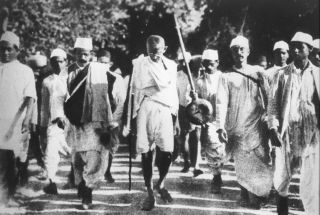Philosophy
How Gandhi’s Non-Violence Is Rooted in Indian Philosophy
Gandhi’s satyagraha influenced both Martin Luther King and Nelson Mandela.
Updated June 11, 2024 Reviewed by Lybi Ma
Key points
- The principle of non-violence runs through all Indian religions, especially Jainism.
- Gandhi extended the Jain principles of non-violence and truthfulness into the political sphere as satyagraha.
- Satyagraha underpinned the Indian Independence Movement as well as the US Civil Rights Movement.

The principle of ahimsa (non-injury or non-violence) runs through all Indian religions, including Hinduism, Buddhism, and, especially, Jainism. It is rooted in the Atman-Brahman doctrine, which implies a commonality, or shared divinity, between all living creatures.
The motto ahimsa paramo dharma (non-violence is the highest virtue) decorates many a Jain temple. The most recognized Jain symbol is a raised hand with, on it, a dharmachakra (wheel of dharma), and within the dharmachakra, the word ahimsa. Even eating honey is seen as violence to the bees that made it.
Jain monks in particular must take special precautions to avoid unintentionally harming a jiva (living being), such as sweeping their path with a peacock-feather duster and not traveling during the rainy season. If you see a Jain monk wearing a mask, it is not because he is afraid of viruses.
There is a Jain story of a fire in the forest. To escape the fire, all the animals crowd around a lake. A restless elephant raises a leg, only for a rabbit to dart into the space beneath. So as not to harm the rabbit, the elephant holds up its leg for three whole days. Although it dies from the strain, it is reborn as a human being.
Many Jains abstain from farming since agricultural operations are bound to injure small animals, including insects and worms. However, violence in self-defence and war can be justified, for example, to protect Jain nuns, and there have been Jain monarchs and even Jain warriors.
Non-violence has worked well for Jains, who are often stereotyped as wealthy merchants and bankers: perhaps ironically, Jains have come to form the wealthiest community in India.
Buddhism and Jainism arose, in part, from a rejection of the Vedic blood sacrifice, and served in turn to accelerate the shift towards vegetarianism in Indian society. The ritual did not die but was transformed, with yagna (sacrifice) replaced by puja, in which the sacrifice is symbolic, with fruits, flowers, and incense offered in lieu of animals. But whereas yagna was a means of effecting a cosmic end, puja was merely a means of propitiating the gods, who had taken control over human affairs, or, at least, set themselves up as middlemen.
Gandhi’s Satyagraha
In his youth, Mahatma Gandhi was deeply influenced by Jainism, which he regarded, rightly or wrongly, as a tradition of Hinduism. He extended the Jain principles of ahimsa and satya (truthfulness, the second of the five great vows taken by Jains) into the political sphere as satyagraha ("holding on to the truth"). This involves tackling injustice with non-violent resistance, truth-telling, and conquering through conversion.
Gandhi practised satyagraha not only in the Indian independence movement but also, in its embryonic form, during his earlier struggles for Indian rights in South Africa. In a letter, he distinguished it from passive resistance in three points: it is a weapon of the strong; it admits of no violence under any circumstance whatsoever; and it ever insists upon the truth.
Gandhi’s satyagraha in turn influenced Martin Luther King, Jr. during the Civil Rights Movement and Nelson Mandela in his struggle against apartheid.
King integrated satyagraha into his vision of Christianity, stating that, “Christ showed us the way and Gandhi in India showed it could work.” Later, he declared Gandhi to be “the greatest Christian of the modern world.”
In 2007, the 88-year-old Mandela addressed a conference to mark the centenary of Gandhi’s satyagraha, stating that Gandhi’s philosophy “contributed in no small measure to bringing about a peaceful transformation in South Africa and in healing the destructive human divisions that had been spawned by the abhorrent practice of apartheid.” “In a world driven by violence and strife, Gandhi’s message of peace and non-violence holds the key to human survival in the 21st century.”
Gandhi looked upon ahimsa and satya as two sides of the same coin: truth leads to non-violence, just as non-violence leads to truth. The means, he said, should be as pure as the end.
Satyagraha is an excellent example of how the ancient world can enlighten the modern.
Read more in Indian Mythology and Philosophy.
References
MK Gandhi: Letter to Someone (Unknown) in Madanpalli. 25 January 1920.
Stanley Rowland, Jr.: 2,500 Here Hail Boycott Leader. New York Times, 26 March 1956.
ML King Jr., 23 June 1962.


